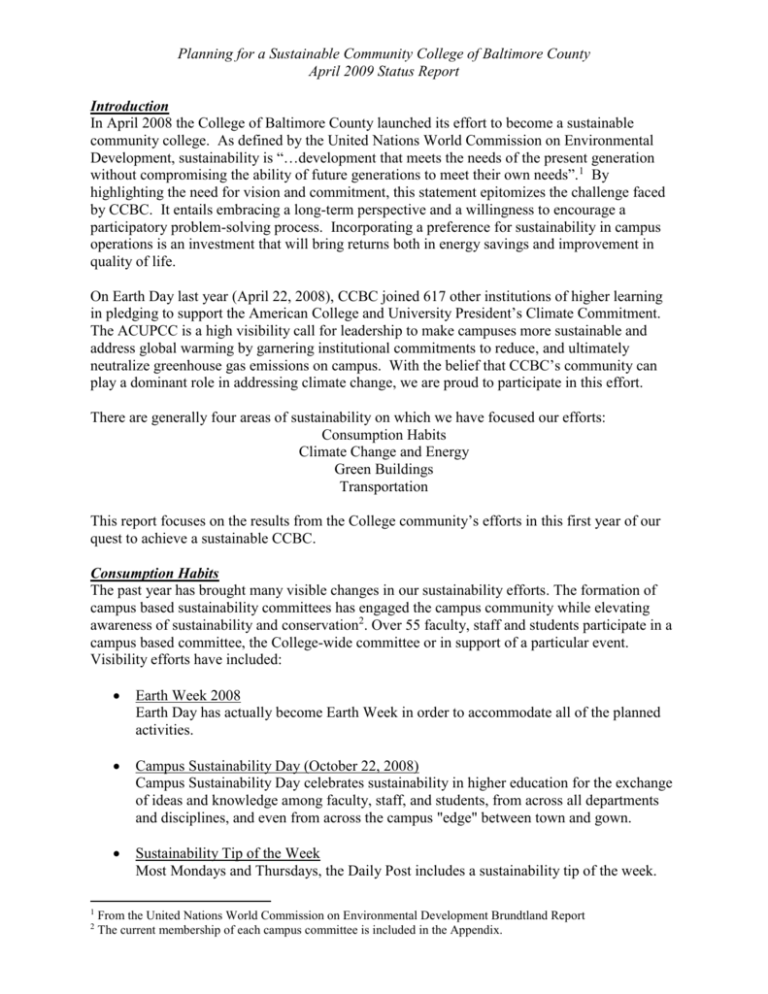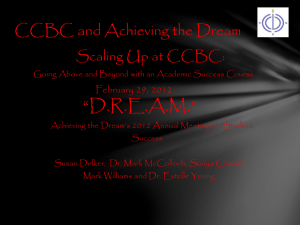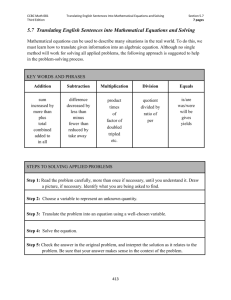Planning for a Sustainable Community College of Baltimore County
advertisement

Planning for a Sustainable Community College of Baltimore County April 2009 Status Report Introduction In April 2008 the College of Baltimore County launched its effort to become a sustainable community college. As defined by the United Nations World Commission on Environmental Development, sustainability is “…development that meets the needs of the present generation without compromising the ability of future generations to meet their own needs”.1 By highlighting the need for vision and commitment, this statement epitomizes the challenge faced by CCBC. It entails embracing a long-term perspective and a willingness to encourage a participatory problem-solving process. Incorporating a preference for sustainability in campus operations is an investment that will bring returns both in energy savings and improvement in quality of life. On Earth Day last year (April 22, 2008), CCBC joined 617 other institutions of higher learning in pledging to support the American College and University President’s Climate Commitment. The ACUPCC is a high visibility call for leadership to make campuses more sustainable and address global warming by garnering institutional commitments to reduce, and ultimately neutralize greenhouse gas emissions on campus. With the belief that CCBC’s community can play a dominant role in addressing climate change, we are proud to participate in this effort. There are generally four areas of sustainability on which we have focused our efforts: Consumption Habits Climate Change and Energy Green Buildings Transportation This report focuses on the results from the College community’s efforts in this first year of our quest to achieve a sustainable CCBC. Consumption Habits The past year has brought many visible changes in our sustainability efforts. The formation of campus based sustainability committees has engaged the campus community while elevating awareness of sustainability and conservation2. Over 55 faculty, staff and students participate in a campus based committee, the College-wide committee or in support of a particular event. Visibility efforts have included: 1 2 Earth Week 2008 Earth Day has actually become Earth Week in order to accommodate all of the planned activities. Campus Sustainability Day (October 22, 2008) Campus Sustainability Day celebrates sustainability in higher education for the exchange of ideas and knowledge among faculty, staff, and students, from across all departments and disciplines, and even from across the campus "edge" between town and gown. Sustainability Tip of the Week Most Mondays and Thursdays, the Daily Post includes a sustainability tip of the week. From the United Nations World Commission on Environmental Development Brundtland Report The current membership of each campus committee is included in the Appendix. Planning for a Sustainable Community College of Baltimore County April 2009 Status Report Earth Hour 2009 Earth Hour began in Sydney in 2007, when 2.2 million homes and businesses switched off their lights for one hour. In 2009, Earth Hour had grown into a global sustainability movement with the goal of 1 billion people switching off their lights as part of a global vote to stand up and take control over the future of our planet. CCBC turned off its lights in areas where safety would not be compromised, at 8:30 p.m. on Saturday, March 28, 2009. CCBC joined such global landmarks as Golden Gate Bridge in San Francisco, Rome’s Coliseum, the Sydney Opera House and the Coca Cola billboard in Times Square, as they stood in darkness for Earth Hour. The culmination of our 2009 efforts is Earth Week. In addition to the unique activities planned for each campus, there are a few events that will occur cross the College. For example, “Sustainability Squads” composed of plant operations staff and sustainability committee members will visit College offices to help each office be “greener”. The squads will: Deliver additional recycling bins and provide instructions on their use Remind office occupants to turn off the lights in unoccupied spaces and ensure that all light switches sport a reminder sticker Deliver power strips with on-off switches that provide more efficient connection of multiple devices to prevent “vampire power”. Post instructions on copier usage to encourage double-sided copying and electronic distribution of materials. Provide a “green certificate” for offices that pledge to incorporate sustainable activities. The Environmental Protection Agency estimates that Americans discard 4.3 pounds of trash per day per person, not including construction debris. The primary action we can take to address this issue is to increase our recycling of paper products. Like any other commodity, the market for recyclables has hit rock bottom over the past year. Since recyclable materials are often the beginning of a manufacturing process, the overall economy has affected our ability to derive funds from our recycling output. Since much of the recyclable paper produced by the U.S. ends up overseas as a pulp product, world economic factors also affect our ability to turn a profit on our recycled materials. We have, therefore, been content to continue our relationship with Vangel Recycling for our paper and cardboard. Plastic bottles, aluminum cans and glass are recycled through the Baltimore County Waste Management Division. While the College has recycled for a number of years, the focus has clearly been lost as evidenced by a 33% college wide reduction in paper recycling from CY2005 (100,327 lbs recycled) to CY2007 (67,358 lbs recycled). However, there has been a 43% increase in recycling since we kicked of our sustainability efforts. We ended CY2008 by recycling 96,657 lbs of paper and cardboard throughout the College. The following chart displays this trend and the paper recycled at each campus. Planning for a Sustainable Community College of Baltimore County April 2009 Status Report Recycled Paper and Cardboard 120,000 100,000 Lbs recycled 80,000 60,000 40,000 20,000 CCBC Essex CCBC Dundalk CCBC Catonsville CY2005 23,300 13,027 64,000 CY2006 27,100 29,225 45,260 CY2007 21,900 10,062 35,396 CY2008 28,119 17,128 51,410 The following scorecard displays the current and future initiatives to make CCBC’s consumption habits more sustainable. 2008 2009 2009 2008 3 CCBC Sustainable Consumption Habits Scorecard3 Create and charge sustainability committees on each campus with membership from faculty, staff and student government. As of April 1, 2009, the CCBC Catonsville committee has 24 members. As of April 1, 2009, the CCBC Essex committee has 45 members. As of April 1, 2009, the CCBC Dundalk committee has 18 members. Create a College-wide sustainability committee and ensure representation from all areas and departments. The College Sustainability Committee met seven times from April 2008 to April 2009. In keeping with its sustainable message, four meetings were in person at one of the campuses and three meetings were conducted over the internet using webcams and meeting software. Change the basis of our waste hauling contracts by paying per pound for waste rather than paying for pick-up frequency regardless of amount. Install trash compactors. A trash compactor was installed at CCBC Catonsville in September, 2008. A trash compactor was installed at CCBC Essex in April, 2009. Kick-off of revamped recycling strategy on Earth Day, April 22, 2008 by distributing paper recycling bins to all offices, classrooms and labs and re-training the custodial staff on appropriate trash segregation techniques. Tasks noted as completed in 2008 were completed on or about April, 2008. Tasks noted as completed in 2009 were completed between April 2008 and April 2009. Planning for a Sustainable Community College of Baltimore County April 2009 Status Report 2008 2009 CCBC Sustainable Consumption Habits Scorecard3 Celebrate Earth Day Week in April 2008 to bring visibility to the College’s efforts. Events included: A planetarium show on The Rare Earth Hypothesis at CCBC Catonsville Viewing of films including The 11th Hour and An Inconvenient Truth Green fairs at each campus A lecture by guest artist and Dundalk native Jackie Bell Johnson on ecofriendly art. Celebrate Sustainability Day on October 22, 2008 at all three CCBC campuses. Events included: Segway rides at each campus with a $10 donation to the United Way CCBC Student Assistance Fund. Free deserts for sustainable activities e.g., using a recyclable coffee mug Viewings of An Inconvenient Truth Displays on sustainable practices, paper saving ideas, and green cleaning A cigarette butt clean-up by the Chi Theta chapter of Phi Theta Kappa at CCBC Essex. Collected butts were on display at the Cyber Café. Guess the number of cigarette butts collected in one week and learn how cigarette waste is harmful to the environment. Celebrate Earth Day Week in April 2009 to bring visibility to the College’s efforts. Events at CCBC Catonsville include: A Green Fair with sustainability themed vendors Pledge for a healthy planet and display of electric vehicles and Segways Give away of reusable water bottles and recycled bags Viewing of the film The Manufactured Landscape A student debate: “Omnivore vs. Vegan: Which is better for the Earth?” 2009 Events at CCBC Dundalk include: Green Scene viewings. 3-5 minute films made by students on various sustainability topics. The Dundalk Renaissance Corporation presentation on the Greening of Dundalk Green Fair including presentations by E-Structors, IKEA and Constellation Energy and the Dundalk Women’s Club Tours of the grounds, tree and flower plantings Demonstration projects on square foot gardening, composting and container gardening Events at CCBC Essex include: Display of Sustainability themed works by members of the Art Club Earth Week fair featuring a variety of sustainability themed booths and displays of our new electric trucks and hybrid cars Speakers from IKEA and Baltimore County Government Grand Opening of the new Essex Fitness Trail Viewing of the film An Inconvenient Truth Planning for a Sustainable Community College of Baltimore County April 2009 Status Report CCBC Sustainable Consumption Habits Scorecard3 Begin recycling bottles and cans as well as paper and cardboard. 2009 Partner with a “single stream” recycling vendor for mixed waste. Install recycling compactors for recyclable materials Consider replacing plastic containers with glass or aluminum in all vending machines. Recycle computer equipment either through donation to other tax exempt/charitable organizations or to a third party equipment recycler. 2008 Recycle batteries, light tubes containing mercury and electronic light ballasts. 2008 2008 Establish purchasing rules to require vendors to comply with minimal packaging requirements. Use native plants in gardens that require less care and water. The Administrative Professionals garden, the Friendly Seniors garden and the Alumni garden at CCBC Essex all have native plants. Sweeney Memorial garden at CCBC Dundalk has native plants. By July 2009 ensure that 50% of our cleaning products and chemicals are Green Seal Certified4. By July 2011, use 100% Green Seal cleaning products and chemicals. Properly train the custodial staff in “Green Cleaning” practices by September, 2008. Use microfiber mops and cloths as a green cleaning technique by January, 2009. 2009 Use entrance matting in buildings to capture dirt as a green cleaning technique. Replace mats as appropriate to ensure adequate walk-off distances. 2008 Increase the usage of post-recycled products such as copy paper, office supplies, paper towels, bath tissue and printer cartridges. Incorporate sustainable practices into College Dining Services by partnering with Sodexo, one of the index components for the Dow Jones Sustainability indices for the World (DJSI World) and Europe (DJSI STOXX). Sodexo offered recyclable bags for sale beginning in August, 2008. Sodexo offered refillable coffee mugs beginning in August, 2008. Sodexo dispenses napkins made from recycled paper. When appropriate to the subject matter, add sustainability as a topic in classroom instruction. 2009 Launch the CCBC Sustainability Website. Establish and publish sustainability performance benchmarks, e.g., recycling rate, energy use/square foot and carbon emissions. 4 The Green Seal organization is a 501 (c) (3) non-profit which has been issuing environmental standards since 1991. Planning for a Sustainable Community College of Baltimore County April 2009 Status Report 2008 2009 2009 CCBC Sustainable Consumption Habits Scorecard3 Create faculty, staff and student “champions for sustainability”. In April 2008, four members of the sustainability committees attended the “Smart and Sustainable Campus” Conference sponsored by the National association of College and University Business Officials at College Park, MD. In April 2009, two members of the sustainability committees attended the conference in College Park, MD. A “sustainability tip of the week” was published in the Daily Post approximately 75% of the time. The May, 2008 Professional Development Day had a sustainability theme. Staff were provided recycling bags. Each Administrative Professionals Day Event in April 2009 will have a sustainability theme. o CCBC Essex’s event will include a talk on “How to Make Your Office Green”. o CCBC Dundalk’s event will include a small container garden. o CCBC Catonsville’s event will include a tree giveaway. Educate faculty, staff and students to: Reduce Examine our consumption habits and see if we can cut back on some things. Reducing saves money, energy and natural resources. Reuse Avoid single use products. Utilize all products to the maximum. Recycle Improve College recycling from the 2007 baseline of 67,358 lbs of cardboard and paper. 2009 In 2008, CCBC recycled 96,657 lbs of cardboard and paper, representing an increase of 43% over CY2007. Rethink Always seek out opportunities to be more efficient. Rethink processes and consumption habits, be creative. Climate Change and Energy The concentration of CO2 in the atmosphere is now 380 parts-per-million (ppm), 100 ppm higher than at the beginning of the Industrial Revolution, circa 1800. This dramatic increase of the atmosphere’s CO2, caused by burning fossil fuels, has been implicated as a primary cause of global warming. Adults today have already felt the average global temperature rise more than a full degree Fahrenheit. Based on modeling by the Intergovernmental Panel on Climate Change, the temperature could increase by more than 7°F (4°C) by the end of the century in the absence of meaningful efforts to rein in global warming pollution.” 5 Did you know that? Lighting accounts for about 20% of all the electricity used in America, costing more than $37 billion annually and accounting for 10% of all CO2 emissions. When you turn on an incandescent light bulb, only 10% of the electricity used is turned into light; the other 90% is wasted as heat. The average American consumes six times more energy than the world average. 5 Source: The Alliance for Climate Protection: www.climateprotect.org/aa19 (3/25/08) Planning for a Sustainable Community College of Baltimore County April 2009 Status Report On average, 16 million tons of carbon dioxide worldwide are emitted into the atmosphere every 24 hours by human use. The American College and University Presidents Climate Commitment requires CCBC as a signatory to complete a comprehensive inventory of all greenhouse gas emissions within one year of signing the commitment. We have estimated that CCBC’s carbon footprint is 28,735,658 lbs of CO2 in FY2009. The graph below shows the composition of CCBC’s carbon footprint. CCBC 2009 Carbon Footprint Total 28,735,658 lbs. of CO2 Faculty & Staff Travel (NonCommuting) , 215,902, 1% Waste Landfilled, 471,656, 2% Utilities (Gas & Electric), 7,618,018, 26% Faculty, Staff & Student Commuting , 20,430,082, 71% One of the significant ways CCBC can address the global climate change is by reducing our energy use. More specifically, we should reduce our consumption of energy made by fossil fuels. CCBC purchases our electricity and natural gas though the Baltimore Regional Cooperative Purchasing Council (BRCPC). Under the Code of Maryland Regulations (COMAR) we are required to purchase 4% of our energy from renewable sources. The Council has locked in our mandated purchases through 2011 using wind generation contracts. The following table provides CCBC’s baseline data in FY2007 compared to FY2008 for energy consumption. The reader will note that CCBC spent over $3.4M for gas and electricity in FY2008. Much of the dollar increase between FY2007 and FY2008 is a result of changes in rates. Planning for a Sustainable Community College of Baltimore County April 2009 Status Report Cost of Natural Gas and Electrical Power CCBC Catonsville CCBC Dundalk CCBC Essex Total FY 2007 $ 1,198,475 $ 621,250 $ 1,096,768 $ 2,916,493 FY 2008 $ 1,333,149 $ 802,504 $ 1,272,346 $ 3,407,998 Natural Gas 12,000,000 270,000 10,000,000 260,000 8,000,000 250,000 Therms Kilowatt Hours Electricity 6,000,000 240,000 4,000,000 230,000 2,000,000 220,000 0 210,000 Kilowatt Hours FY 2007 Catonsville 10,505,562 Dundalk 6,309,450 Essex 10,964,641 Therms FY 2007 Catonsville 256,550 Dundalk 232,260 Essex 239,902 Kilowatt Hours FY 2008 11,069,274 6,862,400 11,403,226 Therms FY 2008 264,246 238,298 248,538 The previous charts show an increase in CCBC’s electrical usage between FY2007 and FY2008 of 1,555,247 kilowatt hours of electricity and 22,370 therms of natural gas. The Department of Energy calculates that commercial building lighting accounts for about 29% of electrical usage. Office equipment, e.g., computers and copy machines, are responsible for consuming another 7% of all commercial-sector power.6 Therefore, some of the most significant changes we can make in our energy consumption are turning off lights and powering down equipment when not in use. The following scorecard displays the current and future initiatives to reduce conserve energy and reduce CCBC’s carbon footprint. CCBC Energy Conservation and Climate Change Scorecard7 Sign the American College and University Presidents’ Climate Commitment. 2008 2009 6 Determine the College’s carbon footprint by April 2009. (Carbon footprint is a measure of the amount of carbon dioxide or CO2 emitted through the consumption of fossil fuels.) Source: The Alliance for Climate Protection: www.climateprotect.org/aj3; www.climateprotect.org/aj2 (3/27/08) Tasks noted as completed in 2008 were completed on or about April, 2008. Tasks noted as completed in 2009 were completed between April 2008 and April 2009. 7 Planning for a Sustainable Community College of Baltimore County April 2009 Status Report CCBC Energy Conservation and Climate Change Scorecard Perform an energy audit at each campus. Retrofit the lighting system to T-8 energy efficient ballasts and lamps at CCBC Catonsville. 2008 Retrofit the lighting system to T-8 or T-5 energy efficient ballasts and lamps at the Essex campus within three years. Retrofit the lighting system to T-8 or T-5 energy efficient ballasts and lamps at CCBC Dundalk within three years. Construct a Central Utility Plant CCBC Catonsville to replace thirteen 40 year old boilers located throughout the campus. 2008 Install an energy management system at CCBC Catonsville, Dundalk and Essex. 2008 Install more monitoring points on the campus energy management systems to improve effectiveness. Install HVAC economizers for use of outside air and HVAC variable speed drives. 2009 Install photovoltaic lighting as a pilot program in a parking lot during FY2009. Determine feasibility for a wider application. Power off all college instructional and office workstations, via network commands, at 11:00 pm 2009 Establish purchasing guidelines for office equipment that mandates ENERGY STAR ratings. Reduce utility consumption by shutting or dialing down HVAC systems and lights during the Thanksgiving holiday, the Winter Recess and Spring Break. 2009 2009 Shut-down Period Thanksgiving Winter Recess Spring Break 2009 Pilot the use of occupancy sensors to turn off lights in classrooms and offices. Occupancy sensors have been installed in: E209, J201, G206 and J100 at CCBC Dundalk E302 and F502 at CCBC Essex G113, H118, W120, W115 and W217 at CCBC Catonsville Establish and publish sustainability performance benchmarks, e.g., recycling rate, energy use/square foot and carbon emissions. Natural Gas Saved 8,837 therms 39,220 therms DNA Electricity Saved (Monthly Period) 301,000 Kwh 168,350 Kwh DNA Reduced Gas and Electric Cost(w/o rate) $63,581 $22,619 DNA Planning for a Sustainable Community College of Baltimore County April 2009 Status Report 2009 CCBC Energy Conservation and Climate Change Scorecard Educate and actively involve faculty, staff and students in various energy saving initiatives including: Turning off lights in unoccupied rooms. Posting reminders on light switches. Activating energy saving stand-by mode on office equipment. Powering off office equipment at the end of the work day. Unplugging devices or turning off the power strip to ensure there is no phantom load, i.e., “vampire power’. Green Buildings Did you know that commercial, institutional and residential building account for approximately: 40% of global consumption of raw materials 30% of primary U.S. energy consumption 12% of U.S. potable water consumption, including 5 billion gallons a day for flushing toilets 136 million tons of construction and demolition debris, annually about 40% of the total U.S. solid waste stream 35% of U.S CO2 emissions The design industry’s response to sustainability has been to create the Leadership in Energy and Environment Design (LEED) program. Prior to 2001, there were no accepted standards defining what constitutes a “Green Building”. The LEED building rating system is a nationally accepted benchmark for high performance green buildings that is administered by the U.S. Green Building Council, a non-profit community of leaders working to make green buildings accessible to everyone within a generation. Within the LEED program, the following five major areas of building performance are considered: sustainable site development, water savings, energy efficiency, materials selection and indoor environmental quality. The LEED system scores a building’s performance by awarding points for meeting detailed standards. There are four rating categories: Certified , Silver, Gold and Platinum. The following scorecard displays the current and future initiatives to make CCBC’s buildings green. 2008 CCBC Green Buildings Scorecard8 Adopt LEED standards for all future building projects. The Owings Mills Facility is being designed towards a certified rating. The new Catonsville Library is being designed towards a Silver certification. This project has been registered with the U.S. Green Building Council. Become a United States Green Building Council (USGBC) member. Benefits include savings on project registration and certification fees, reduced prices on training workshops and individual LEED AP (Accredited Professional) Exam, as well as savings on USGBC printed materials. Renovation of Lounge area in CCBC Catonsville Q Building. This project included lighting and ceiling upgrades. The 75 incandescent lighting was 2009 8 Tasks noted as completed in 2008 were completed on or about April, 2008. Tasks noted as completed in 2009 were completed between April 2008 and April 2009. Planning for a Sustainable Community College of Baltimore County April 2009 Status Report 2009 2009 2009 replaced with 42 watt compact fluorescent bulbs. The intensity of the lighting increased from 18 to 42 foot candles while reducing the energy consumption by 37%. Renovation of E Building at CCBC Essex Although this renovation project was not LEED certified, it contained many elements of sustainable architecture including: replacement of all windows with energy efficient glazing, new energy efficient HVAC systems including automated building controls, installation of a single ply reflective roofing, and installation of energy efficient light fixtures. Planning is underway to re-fixture and add lamp poles to Parking Lot #1 at CCBC Essex using Light Emitting Diode (LED) technology. LED’s extend the life span of the bulb while reducing the kilowatt usage and adding more light. A walking and nature trail will be opened at CCBC Essex during Earth Week, 2009. The mulch base for the trail was recycled from the clearing of undergrowth from parking lot islands on the campus. Transportation Burning gasoline (a fossil fuel) in vehicles is one of the largest contributors to CO2 emissions. We can improve the climate by reducing the amount of gasoline that we use. The following table describes the average transportation profile of people in greater Baltimore. Annual miles traveled by car per household Percentage of trips taken by car Percentage of trips taken by mass transit Percentage of trips taken by foot Percentage of trips taken by bicycle 20,170 miles 82.2% 2.6% 8.1% 0.2% As the three campuses come together as one college, we have probably increased our travel. We now need to look at sharing rides and utilizing other technology to reduce our use of gasoline. For the 2008-2009 academic year, we piloted a shuttle service between CCBC Dundalk and CCBC Essex. The following chart details the ridership through the eighth week of the semester. Total Weekly Ridership 180 160 140 120 100 80 60 40 20 Fall 1 Fall 2 Fall 3 Fall 4 Fall 5 Fall 6 Fall 7 Fall 8 Fall 9 Fall 10 Fall 11 Fall 12 Fall 13 Fall 14 Fall 15 Fall 16 Spr 1 Spr 2 Spr 3 Spr 4 Spr 5 Spr 6 Spr 7 Spr 8 Spr 9 Spr 10 Spr 11 Spr 12 Spr 13 Spr 14 Spr 15 Spr 16 0 Planning for a Sustainable Community College of Baltimore County April 2009 Status Report On average, 125 students and faculty rode the shuttle between the Dundalk and Essex campuses each week. This has reduced our carbon footprint by 2,261 lbs of CO2 in the first eight weeks of the spring semester. Since commuting composes over 71% of the College’s carbon footprint, we need to make additional inroads to reducing commuting to class and work. In addition, we have made a conscious effort to use green technologies in our plant operations. In February we replaced two of our older fleet pick-up trucks with electric trucks. (One of the trucks is pictured here.) The following scorecard displays the current and future initiatives to make CCBC’s transportation more sustainable. 2009 CCBC Sustainable Transportation Scorecard9 Purchase hybrid vehicles. During our regular vehicle replacement cycle, one fleet vehicle at CCBC Essex was replaced with a Toyota Prius. The purchase of two hybrid vehicles for public safety will be recommended at the June 2009 Board meeting. Pilot the use of Segway personal transportation vehicles for public safety patrols. Purchase one Segway for each campus. 2009 2009 9 Purchase alternative fuel (electric) vehicles for Plant Operations on campus use. Two electric trucks were purchased in February, 2009 for use at CCBC Catonsville and CCBC Essex. Encourage ride sharing and carpooling among faculty, staff and students by creating premium carpooling parking spaces. Tasks noted as completed in 2008 were completed on or about April, 2008. Tasks noted as completed in 2009 were completed between April 2008 and April 2009. Planning for a Sustainable Community College of Baltimore County April 2009 Status Report 2009 2009 CCBC Sustainable Transportation Scorecard9 Improve video conferencing and on-line meeting capabilities to encourage more meetings via this methodology. Breeze web conferencing software was purchased and piloted for various meetings. The sustainability committee met three times this year using this methodology. The Administrative Services Leadership Team met two times this year using this methodology. Several other committees used the software. Change the behavior of faculty, staff and students to: Use Public Transportation Walk or Bike Pilot a Shuttle between Campuses. The Essex – Dundalk Shuttle began service for the fall 2008 semester. Ridership has averaged 125 students and employees per year. Establish and publish sustainability performance benchmarks, e.g., recycling rate, energy use/square foot and carbon emissions. Formulate and Institute Vehicle Idling Standards for Plant Operations and Public Safety vehicles. 2009 Conclusion The past year has brought increased enthusiasm for our sustainability efforts at CCBC. As we strive to not only “Live Green” we also want to “Learn Green” and do our part to contribute to providing a cleaner planet for generations to come. APPENDIX 2009 Sustainability Committee Membership CCBC Catonsville Patricia Rhea, Chair Jo Anne Blum Lynnea Booth Terri Booth Greta Franklin Kathleen Gandy Ellen Lathrop-Davis Brian Gunn Cheryl Kantorski Maureen McLaughlin Mark Neal Paula Noeller Rod Pullen Michelle Pusinsky Patricia Ramsey Nancy Reed Tonja Ringgold Sonja Schmitz Jeanne Sengebusch Keenan Smith Michael Stanley Jennifer Wiley Terry Wolfe CCBC Essex Encarni Trueba, Chair Jaime Alvarez Denise Blackburn Nancy Bogage Candy Carr-Smith Laura Cucci Sarah Cullip Christine Destefano Patricia Harrigan Michele Knoerlein Brad Ranno Terri Raulie John Reisig Gayle Restivo Karen Roettger Mary Schatz-Wonneman Elizabeth Shrader Ileane Smith Al Starr Carla Swingler Courtney Topolski Karen Valentin Kate Van De Wal Amy Wilson Judy Woke Harriet Zlotowitz Karly Chester Fawn Leipold Shaneeka Hughes Lena Redding Latisha Johnson Chansa Kasolo Jessica Rich Andrew Arciaga Rhyner Washburn Audrey Ndaba Lauren Wheatley Lovemore Chirombo Andrew Violant Cameron Torres Nicole Wheatley CCBC Dundalk Jay Zumbrun, Chair Jordan Bethea Sharon Casey Bill DeLauder Shakuntala Dhanesar Crissy Fabriszak Patricia Hall Roy Hoopengardner Mary Jo Garcia Libby Kennedy Lynn Kramer Anne Markham Ken MacLaughlin Kevin Mick Pat Pritchard Candy Richardson Carol Sullivan Michael Walsh









